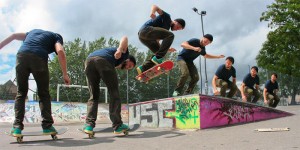

Get to Know Your Camera’s Drive Modes
Camera Tips October 14, 2015 Editorial Staff 0

Before you go to CVS Photo and have your pictures printed, make sure you take the time to learn about your camera’s drive modes, because proper use is going to make a difference in terms of quality output. Cameras today have multiple modes, but the following are the most common.
Single Shot
In single shot mode your camera is going to record all the images each you press the shutter release. Even if the button is pressed down your camera will take only one shot, ensuring no photos are accidentally taken if you don’t get to lift your finger off the button quickly enough. Single shot mode is ideal for portraits, still life and landscape shots, but it’s not suitable for action because you have to keep pressing the shutter release.
 Continuous Shooting
Continuous Shooting
As the name implies, under this mode your camera will take shots as long as the shutter is pressed or until the card or buffer is filled up. When in continuous autofocus mode, your camera refocuses automatically between taking pictures. Most cameras have high and low continuous shooting options: when set to high the camera shoots at the maximum frame rate, but this can be adjusted.
Continuous shooting is suitable for action and sport photography so you don’t miss out on anything. Just make sure that your camera doesn’t lose focus when the frame rate is at the maximum. If your subject is veering away or moving towards you, set the continuous shot to low so it will have a better chance of focusing.
For every day shots the low continuous shot is ideal because you have the option to put your finger on the shutter release and continue shooting if the need arises. However your camera is going to shoot more slowly, but it does reduce the risk of capturing unnecessary shots.
The Self Timer
If your camera is in self-timer mode, it won’t take a shot after you press the shutter release, not until the specific time you set. This feature is most useful if you want to be in the photo. Timers usually have a delay between 2 to 10 seconds, giving you plenty of time to get into the scene and pose.
Remote Release
The remote release mode in your camera allows you to use the camera with a remote release, often with wireless or cable options. With this option you can activate the shutter and take photos without making contact with the camera, great if you want to avoid vibrations that lead to image blurring.
Mirror Lockup
Some cameras have a mirror lockup feature that when activated, allows the camera to take an image after the lifting of the camera’s mirror. This feature isn’t always available, but it’s good to have if the shutter speed isn’t high and you don’t want to compromise quality.
The mirror lockup option is also suitable for photographers who want to shoot macro photos, still life and landscape. You can use the camera as is but for best results pair it up with a remote release and a tripod.

No comments so far.
Be first to leave comment below.